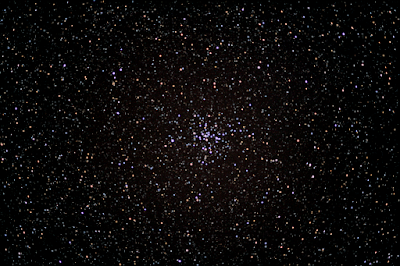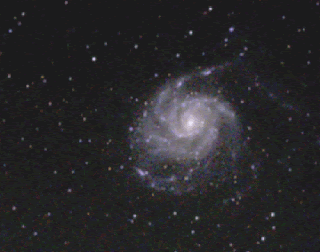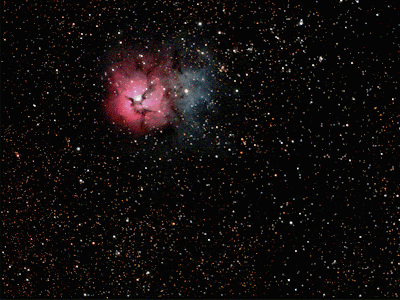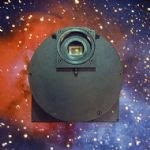
I've added a second image featuring M-41. As with the M-35 image, what really intrigues me in the image are the dim bulbs.
Having lived in Flagstaff for nearly a decade, I got to know several of the local professional astronomers . While Lowell’s new "Discovery telescope" will be dedicated to the search for NEO’s, a significant part of the USNO’s research program involves measuring the parallax of the "dim bulbs" – otherwise known as red dwarfs. It's a treat to view some through the 155m (61") astrometric reflector. Link:
http://www.nofs.navy.mil/The bright stars and the Milky Way itself tend to mesmerize the lovers of the night sky. Of course! The visual threshold, as all amateurs known, is mag 6.0 (and for people with really sharp "peepers" slightly beyond that). From a dark site on a moonless night, then, about 3000 stars can be viewed without optical aid on any one evening. As it turns out, however, those stars are just the tip of the galactic iceberg. The dim bulbs constitute the overwhelming majority of stars, perhaps as high of 90 percent of the total number.
One of my favorite astronomical writers is Chet Raymo. "For every yellow star like our sun in the middle of the main sequence," he writes, "there may be ten times as many red dwarfs" (p. 66,
365 Starry Nights).
Raymo’s on solid ground. James Kater’s excellent
The Hundred Greatest Stars (a must have, in my opinion) writes that "by the far the most numerous kinds of stars are the faint M, L, and T dwarfs, which constitute at least 80 percent of the whole tally. As one climbs the main sequence, the numbers quickly drop; fewer than one star in a million is class O" (p. xx, Kater).
The Rigel’s, in other words, are the stellar freaks! It’s the dim bulbs that are the average Joe’s. All of these stars are, of course, invisible to the naked eye. In fact, most of them are beyond the reach of smaller aperture amateur telescopes. Which is why, when I first "stretched" the image of M35/NGC2158 and saw all those dim bulbs the experience was an immediate "Shazam, Holy cow, unreal, dude!" astronomical surprise.
Color me a rookie, eh? ;-) I was preoccupied with the techniques of astroimaging and conceptually disengaged – i.e., smacked with a stupid stick. The contemporary era of charge-coupled-collecting devices, computers and such has revolutionized stellar study, including the study of the dim bulbs. And the results have tended to upset the accepted picture of star formation and distribution. The accepted hypothesis has been that stars were born in stellar nurseries like the M42 complex, formed clusters like M35, and eventually wandered off as "single stars" – for example, Sol.
To make a long story short: "[I]n the last 15 years or so, astronomers have used more sensitive telescopes to survey smaller, dimmer stars called red dwarfs, which are between 10% and 50% the mass of the Sun. ‘The faint stars are harder to see, but they make up 85% of all stars in the galaxy, and three quarters of those are single,’ [according to astrophysicist Charles] Lada.... ‘I think the result strongly favors the idea that most stars form initially as single objects, not in multiple systems.’ "
"That goes against current models, which explain the existence of single stars by arguing they are born with siblings and are then separated after a gravitational interaction with another star. ‘You can certainly form a lot of stars that way, but with so many single red dwarfs, there's no simple way’ to explain them all, says Lada."
Source:
http://space.newscientist.com/article/dn8640.htmlLet me direct your attention back to the image of M35 from yesterday.Whoa, Nelly, that’s a whole lot of single stars, eh! And wow, are they dim. Makes me wonder just how low can we go in that image? Meaning, how faint are those dim bulbs? The starfield through my C14, which has a limiting magnitude around 15.3 (according to the manual: in use maybe mag 12 or so), is nowhere as rich as the image.
Let me use one of my planetarium programs to grope for answer. In my normal settings for The Sky no stars dimmer than mag 14 appear. With that setting the star field is clearly not as rich as the star field in the image. Left-clicking on the smallest stars gives data such as:
Object name: GSC 1868:2661
Magnitude: 13.7
Object name: GSC 1868:1857
Magnitude: 13.4
If I tweak "The Sky" (>"View"> "Stellar Options">"more stars" (move the slider for "more stars" all the way to the left) I can repopulate the "stellar field" with some really faint stars like these:
Object name: GSC 1881:232
Magnitude: 14.6
Object name: GSC 1881:744
Magnitude: 15.6
GSC1881:774 is the faintest star I can find. There may be some fainter ones. And by adding additional catalogues I might be able to tweak The Sky stellar field in the vicinity of M35 to approximate that of the image. But as a close comparison of the image and The Sky’s stellar field makes clear, there’s a bunch of dim bulbs in the image not on The Sky. For example, study the field at about 7 o’clock very near to M35.
Thus, a provisional answer to the question of "how low can you go with 5 minutes worth of subs?" Pretty low. Mag 16? Mag 17? I’m not sure.
In any case: Sagan was right. Billions and billions of stars. Most of them dim bulbs.
Cheers.
Max
More technical details concerning red dwarfs can be found online.
1. A short defintion and discussion at:
http://www.astro.umd.edu/educationalresources/astro/stev/rdwarf.html2. Red dwarfs within 10 parsecs of Sol (a must see):
http://www.solstation.com/stars/pc10rds.htm3. Short discussion with links:
http://jumk.de/astronomie/about-stars/red-dwarfs.shtml











































